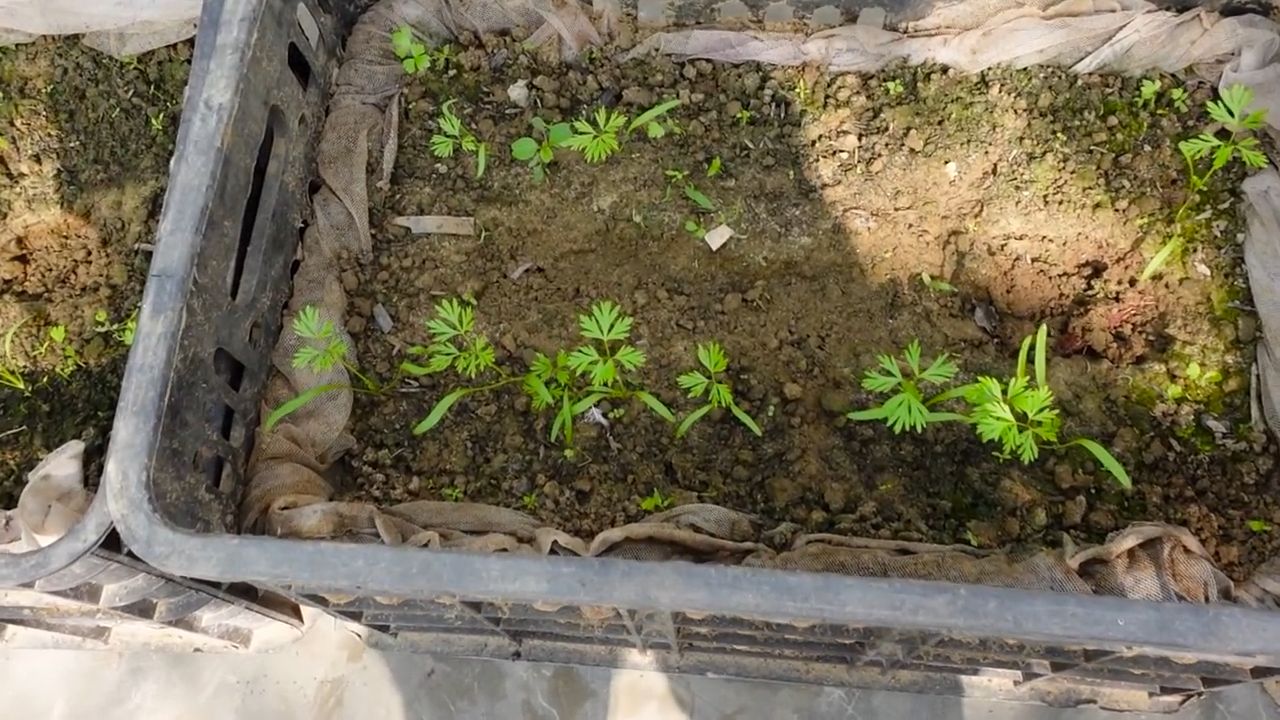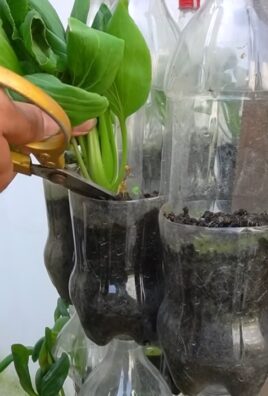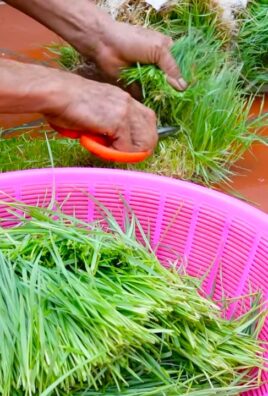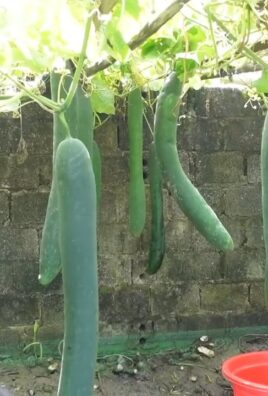Grow Purple Carrots Harvest and unlock a vibrant, healthy, and surprisingly easy addition to your home garden! Have you ever imagined pulling a carrot from the earth, not orange, but a stunning shade of purple? It’s not just a whimsical dream; it’s an achievable reality with a few simple tricks and a little DIY spirit. For centuries, before the familiar orange variety dominated our plates, purple carrots were the norm, particularly in regions like the Middle East and Asia. They’re packed with antioxidants and offer a unique, slightly sweeter flavor profile compared to their orange cousins.
But why should you bother with this DIY project? Well, beyond the sheer novelty and bragging rights, growing your own purple carrots allows you to control what goes into your food. No pesticides, no hidden chemicals – just pure, delicious goodness straight from your garden to your table. Plus, it’s incredibly rewarding to nurture something from seed to harvest. I’m going to show you some simple, effective DIY tricks to ensure a bountiful Grow Purple Carrots Harvest, even if you’re a complete beginner. Get ready to add a splash of color and a boost of nutrition to your life!

Lila Karotten selbst anbauen und ernten: Ein umfassender DIY-Leitfaden
Hallo liebe Gartenfreunde! Habt ihr Lust, etwas Farbe in euren Gemüsegarten zu bringen? Dann lasst uns gemeinsam lila Karotten anbauen! Es ist einfacher als ihr denkt und das Ergebnis ist nicht nur optisch ein Highlight, sondern auch geschmacklich eine Bereicherung. Ich zeige euch, wie ihr von der Aussaat bis zur Ernte alles richtig macht.
Warum lila Karotten?
Bevor wir loslegen, kurz ein paar Worte, warum ich so begeistert von lila Karotten bin. Sie sind nicht nur wunderschön, sondern auch reich an Anthocyanen, starken Antioxidantien, die unsere Gesundheit unterstützen. Außerdem sind sie oft etwas süßer als orange Karotten und haben einen leicht würzigen Geschmack. Und mal ehrlich, wer kann schon einem lila Karottensalat widerstehen?
Die richtige Sorte wählen
Es gibt verschiedene Sorten lila Karotten. Hier sind ein paar meiner Favoriten:
* Purple Haze: Eine beliebte Sorte mit dunkellila Schale und orangefarbenem Kern. Sie ist knackig und süß.
* Purple Dragon: Diese Sorte ist komplett lila, sowohl innen als auch außen. Sie hat einen intensiven Geschmack.
* Cosmic Purple: Eine weitere Sorte mit lila Schale und orangefarbenem Kern. Sie ist bekannt für ihre gute Lagerfähigkeit.
Wählt die Sorte, die euch am besten gefällt und die in eurer Region gut wächst. Informiert euch am besten im Fachhandel oder online über die spezifischen Anforderungen der jeweiligen Sorte.
Vorbereitung ist alles: Der richtige Standort und Boden
Karotten lieben einen sonnigen Standort. Mindestens sechs Stunden Sonne pro Tag sind ideal. Der Boden sollte locker, sandig und gut durchlässig sein. Staunässe vertragen Karotten überhaupt nicht.
Boden vorbereiten:
1. Boden lockern: Lockert den Boden gründlich auf, idealerweise bis zu einer Tiefe von 30 cm. Entfernt Steine, Wurzeln und andere Hindernisse.
2. Kompost einarbeiten: Mischt reifen Kompost unter den Boden. Kompost verbessert die Bodenstruktur, speichert Feuchtigkeit und versorgt die Karotten mit Nährstoffen.
3. Sand hinzufügen: Wenn euer Boden sehr lehmig ist, fügt etwas Sand hinzu, um die Drainage zu verbessern.
4. Keine frische Düngung: Vermeidet frische Düngung mit Mist oder Gülle, da dies zu “haarigen” Karotten führen kann. Karotten bevorzugen einen eher nährstoffarmen Boden.
Aussaat: Der Grundstein für eine reiche Ernte
Der beste Zeitpunkt für die Aussaat von Karotten ist im Frühjahr (April/Mai) oder im Sommer (Juli/August) für eine Herbsternte.
So geht’s:
1. Saatrillen ziehen: Zieht mit einem Stock oder einer Hacke Saatrillen mit einem Abstand von etwa 20-30 cm zueinander. Die Rillen sollten etwa 1-2 cm tief sein.
2. Samen aussäen: Säet die Karottensamen dünn in die Rillen. Karottensamen sind sehr klein, daher ist es wichtig, nicht zu viele Samen auf einmal auszusäen. Ihr könnt die Samen auch mit etwas Sand vermischen, um sie besser verteilen zu können.
3. Mit Erde bedecken: Bedeckt die Samen vorsichtig mit Erde und drückt sie leicht an.
4. Angießen: Gießt die Saatrillen vorsichtig an. Achtet darauf, dass die Erde feucht, aber nicht nass ist.
Pflege: Gießen, Unkraut jäten und vereinzeln
Die Pflege ist entscheidend für eine erfolgreiche Karottenernte.
Gießen:
* Gießt die Karotten regelmäßig, besonders während trockener Perioden. Achtet darauf, dass die Erde gleichmäßig feucht bleibt.
* Vermeidet Staunässe, da dies zu Wurzelfäule führen kann.
Unkraut jäten:
* Haltet das Beet unkrautfrei. Unkraut konkurriert mit den Karotten um Nährstoffe und Wasser.
* Jätet das Unkraut vorsichtig, um die zarten Karottenwurzeln nicht zu beschädigen.
Vereinzeln:
* Wenn die Karottenpflänzchen etwa 2-3 cm groß sind, müsst ihr sie vereinzeln. Das bedeutet, dass ihr die zu dicht stehenden Pflänzchen entfernt, damit die verbleibenden Karotten genügend Platz zum Wachsen haben.
* Lasst zwischen den einzelnen Karottenpflänzchen etwa 4-5 cm Platz.
* Zieht die überzähligen Pflänzchen vorsichtig heraus, um die Wurzeln der verbleibenden Pflänzchen nicht zu beschädigen.
Schutz vor Schädlingen und Krankheiten
Karotten können von verschiedenen Schädlingen und Krankheiten befallen werden. Hier sind einige Tipps, wie ihr eure Karotten schützen könnt:
* Karottenfliege: Die Larven der Karottenfliege fressen an den Karottenwurzeln und können großen Schaden anrichten. Um die Karottenfliege fernzuhalten, könnt ihr ein Kulturschutznetz über das Beet spannen.
* Wurzelälchen: Wurzelälchen sind winzige Fadenwürmer, die an den Karottenwurzeln saugen und zu Wuchsdepressionen führen können. Eine Fruchtfolge mit Pflanzen, die nicht von Wurzelälchen befallen werden (z.B. Ringelblumen), kann helfen.
* Falscher Mehltau: Falscher Mehltau ist eine Pilzkrankheit, die sich durch einen weißen Belag auf den Blättern äußert. Sorgt für eine gute Belüftung und vermeidet Staunässe, um den Falschen Mehltau vorzubeugen.
Ernte: Der Lohn der Mühe
Die Erntezeit für Karotten hängt von der Sorte und dem Aussaatzeitpunkt ab. In der Regel sind Karotten etwa 2-3 Monate nach der Aussaat erntereif.
So geht’s:
1. Erntezeitpunkt bestimmen: Die Karotten sind erntereif, wenn sie die gewünschte Größe erreicht haben. Ihr könnt vorsichtig eine Karotte aus der Erde ziehen, um zu überprüfen, ob sie reif ist.
2. Karotten ernten: Lockert die Erde um die Karotten herum mit einer Grabegabel oder einem Spaten auf. Zieht die Karotten vorsichtig am Grün aus der Erde.
3. Grün entfernen: Entfernt das Grün der Karotten, um zu verhindern, dass sie austrocknen.
4. Reinigen: Reinigt die Karotten von Erde.
Lagerung: Damit die lila Pracht lange hält
Karotten lassen sich gut lagern, wenn sie richtig behandelt werden.
So geht’s:
1. Beschädigte Karotten aussortieren: Sortiert beschädigte Karotten aus, da diese schnell faulen können.
2. Kühl und dunkel lagern: Lagert die Karotten an einem kühlen, dunklen und feuchten Ort, z.B. im Keller oder im Kühlschrank.
3. In Sand einschlagen: Ihr könnt die Karotten auch in feuchten Sand einschlagen, um sie länger frisch zu halten.
4. Nicht waschen: Wascht die Karotten vor der Lagerung nicht, da dies die Haltbarkeit verkürzt.
Verwendung: Kreative Rezeptideen mit lila Karotten
Lila Karotten sind vielseitig einsetzbar. Hier sind ein paar meiner Lieblingsrezepte:
* Lila Karottensalat: Ein bunter Salat mit lila Karotten, Äpfeln, Nüssen und einem leckeren Dressing.
* Lila Karottensuppe: Eine cremige Suppe mit lila Karotten, Ingwer und Kokosmilch.
* Gebratene lila Karotten: Einfach und lecker: Lila Karotten mit Olivenöl, Kräutern und Gewürzen im Ofen gebraten.
* Lila Karottenkuchen: Eine ungewöhnliche Variante des klassischen Karottenkuchens.
Lasst eurer Kreativität freien Lauf und probiert neue Rezepte mit lila Karotten aus!
Zusätzliche Tipps und Tricks
* Fruchtfolge beachten: Baut Karotten nicht jedes Jahr am selben Standort an, um Krankheiten und Schädlingen vorzubeugen.
* Beetnachbarn: Gute Beetnachbarn für Karotten sind Zwiebeln, Knobl

Conclusion
So, there you have it! Growing your own purple carrots from seed to harvest is not only achievable, but it’s also a deeply rewarding experience that brings a vibrant splash of color and a boost of nutrition to your table. Forget the ordinary orange – embracing the purple revolution in your garden opens up a world of culinary possibilities and adds a touch of magic to your meals.
Why is this DIY trick a must-try? Because it empowers you to control the quality and freshness of your produce. Store-bought carrots, even the purple varieties, often lack the intense flavor and vibrant color that homegrown ones possess. Plus, you’ll be reducing your carbon footprint by sourcing your food locally – right from your own backyard! And let’s not forget the sheer joy of nurturing a plant from a tiny seed to a beautiful, edible creation. It’s a connection to nature that’s hard to beat.
But the fun doesn’t stop there! Feel free to experiment with different varieties of purple carrots. ‘Purple Dragon’ offers a spicy kick, while ‘Cosmic Purple’ boasts a sweeter flavor. You can also try interplanting your carrots with companion plants like onions or rosemary to deter pests and enhance growth. Consider succession planting – sowing seeds every few weeks – to ensure a continuous harvest throughout the growing season. For a unique twist, try roasting your purple carrots with a drizzle of honey and a sprinkle of sea salt to bring out their natural sweetness. Or, grate them into salads for a pop of color and a boost of antioxidants. You can even pickle them for a tangy and visually stunning condiment.
The possibilities are endless!
We wholeheartedly encourage you to embark on this purple carrot growing adventure. It’s a project that’s suitable for gardeners of all skill levels, from beginners to seasoned pros. Don’t be afraid to get your hands dirty and embrace the learning process. Remember to document your journey, take photos of your progress, and most importantly, have fun!
Once you’ve harvested your beautiful purple bounty, we’d love to hear about your experience. Share your tips, tricks, and photos with us in the comments section below. Let’s create a community of purple carrot enthusiasts and inspire others to embrace the joy of homegrown goodness. What challenges did you face? What successes did you celebrate? What are your favorite ways to prepare and enjoy your purple carrots? Your insights will be invaluable to fellow gardeners.
So, grab your seeds, prepare your soil, and get ready to witness the magic of growing purple carrots. It’s an experience you won’t regret! Happy gardening!
Frequently Asked Questions (FAQ)
What are the benefits of growing purple carrots compared to orange carrots?
Purple carrots offer several advantages over their orange counterparts. Firstly, they are packed with anthocyanins, powerful antioxidants that are responsible for their vibrant color and offer numerous health benefits, including reducing inflammation and protecting against chronic diseases. While orange carrots are rich in beta-carotene, purple carrots provide a wider range of antioxidants. Secondly, homegrown purple carrots often have a more intense and complex flavor than store-bought varieties. Finally, growing purple carrots adds a unique visual appeal to your garden and your meals.
What kind of soil is best for growing purple carrots?
Purple carrots, like all carrots, thrive in loose, well-drained soil that is free of rocks and debris. Rocky soil can cause the roots to split or become misshapen. The ideal soil pH is between 6.0 and 6.8. Before planting, amend your soil with compost or well-rotted manure to improve drainage and fertility. Avoid using fresh manure, as it can cause the roots to fork. If your soil is heavy clay, consider growing your carrots in raised beds or containers filled with a suitable potting mix.
How much sunlight do purple carrots need?
Purple carrots require at least six hours of direct sunlight per day to thrive. Choose a sunny location in your garden where they will receive ample sunlight throughout the growing season. If you live in a hot climate, providing some afternoon shade can help prevent the roots from becoming bitter.
When is the best time to plant purple carrots?
The best time to plant purple carrots depends on your climate. In cooler climates, you can sow seeds directly into the garden in early spring, as soon as the soil can be worked. In warmer climates, you can plant in late summer or early fall for a winter harvest. Carrots prefer cooler temperatures, so avoid planting during the hottest months of the year. Check your local planting calendar for specific dates.
How often should I water my purple carrots?
Purple carrots need consistent moisture to develop properly. Water deeply and regularly, especially during dry periods. Aim to keep the soil consistently moist but not waterlogged. Avoid overhead watering, as it can promote fungal diseases. A soaker hose or drip irrigation system is ideal for watering carrots.
How long does it take for purple carrots to mature?
Purple carrots typically take 70-80 days to mature, depending on the variety and growing conditions. You can start harvesting them when they reach a size that is suitable for your needs. Smaller carrots will be more tender, while larger carrots will have a more intense flavor.
What are some common pests and diseases that affect purple carrots?
Common pests that affect purple carrots include carrot rust flies, aphids, and nematodes. Carrot rust flies lay their eggs near the base of the plants, and the larvae burrow into the roots, causing damage. Aphids suck the sap from the leaves, weakening the plants. Nematodes are microscopic worms that live in the soil and feed on the roots. To prevent pest problems, practice crop rotation, use row covers, and introduce beneficial insects like ladybugs and lacewings. Common diseases that affect purple carrots include leaf blight and powdery mildew. To prevent disease problems, provide good air circulation, avoid overhead watering, and use disease-resistant varieties.
Can I grow purple carrots in containers?
Yes, you can successfully grow purple carrots in containers, provided that you choose a container that is large enough to accommodate their root growth. A container that is at least 12 inches deep and 12 inches wide is recommended. Use a well-draining potting mix and ensure that the container has drainage holes. Water regularly and fertilize with a balanced fertilizer.
How do I store purple carrots after harvesting?
To store purple carrots after harvesting, remove the tops and gently brush off any excess soil. Store them in a cool, dark, and humid place, such as a refrigerator or root cellar. You can wrap them in a damp cloth or store them in a plastic bag with air holes to prevent them from drying out. Properly stored purple carrots can last for several weeks or even months.
Why are my purple carrots not turning purple?
Several factors can contribute to purple carrots not developing their characteristic color. Insufficient sunlight, poor soil conditions, and high temperatures can all inhibit anthocyanin production. Ensure that your carrots are receiving at least six hours of direct sunlight per day, that your soil is well-drained and fertile, and that you are planting them during a cooler part of the year. Some varieties of purple carrots also develop their color more intensely than others.




Leave a Comment